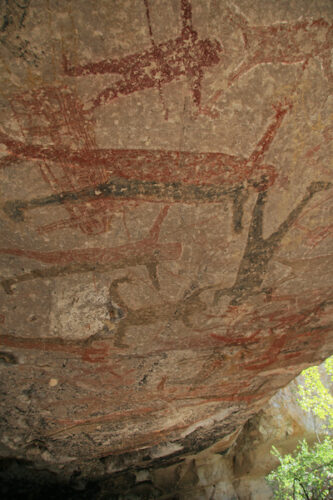
Just northeast of Mulegé, tucked into the Sierra de Guadalupe mountains, are the oldest cave paintings in North America—San Borjitas. Carbon dated to be 7,500 years old, these are not only the oldest cave paintings on the continent, but some of the most impressive in Baja California. They are also relatively easy to visit, with the proximity to Mulegé and fairly uncomplicated access, they can be visited in a day trip (as opposed to the multi-day pack animal trek that is required to reach the impressive sites in the Sierra de San Francisco).
The canvas for the San Borjitas paintings is a 30-meter long cave overhang with the ceiling containing over 80 monos (human figures). The paintings are considered to be a sub-style of the figures in the Sierra de San Francisco. The feature that distinguishes San Borjitas from most other sites on the peninsula is the bi-color figures with one half painted in black and the other half in red. The monos at San Borjitas have long, bulging torsos with short splaying legs, arms thrust out at awkward 90 degree angles, and no necks. The monos also appear at right angles to one another, another distinguishing feature for the San Borjitas paintings. Baja author and cave painting expert Harry Crosby wrote that “they appear to form an open network of bodies woven together at consistent 90-degree angles” which is a characteristic not found in any other known cave paintings in Baja California. There are numerous arrows that appear over and through the monos, making the whole depiction appear as though it’s a native war scene, seen through the eyes of a modern artist.
With the overhang more than 20 feet off of the ground, it’s still a mystery how the paintings got there in the first place. The earliest recordings of the cave paintings were from missionary Padre Francisco Escalante in 1772, but the local and indigenous people had known about the paintings for long before this. When the missionaries arrived and asked the native Cochimí who had created the paintings, they responded that it had been an ancient race of giants.
Farther back in the cave is an area where the ceiling and back of the cave have been blackened by fire. Some figures of deer and fish have been scratched into the black areas here. To the side of the cave is a wall of vulvas which was believed to be used in rites of passages for adolescents and/or fertility reasons.
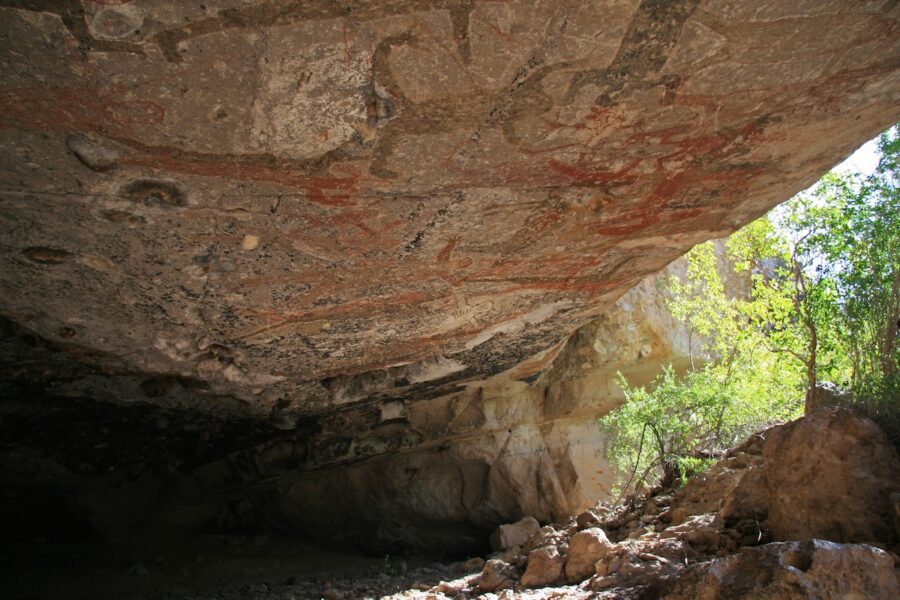
Going On Your Own
Heading to San Borjitas without a guide means you’ll need a high-clearance, four-wheel drive and a sense of adventure. As per INAH (Instituto Nacional de Antropología e Historia, Mexixo’s National Institute of Anthropology and History) guidelines, you’ll still need to hire a guide to take you to see the cave paintings, so you’ll drive to Rancho Las Tinajas in the area of San Baltazar (GPS 26.89165, -112.26610) and inquire about a guide from there who will lead you to the paintings. From Highway Mexico 1, the turn off for Rancho Las Tinajas is at Km 165. It’s a rigorous off-road drive for 20 miles through riverbeds, deep sand, and large rocks. Expect the drive to take about two hours. At Rancho Las Tinajas, you will pay for a permit and guide (cost is about $10 US per person, which will need to be paid in cash) who you’ll follow about another three miles to a parking area for San Borjitas. From there, it’s about a 20-minute moderate hike through bushes and steep rocky areas to get to the cave paintings.
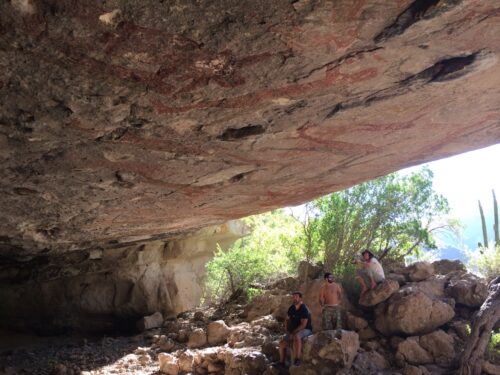
Guided Tours
There are a couple of options for guided tours to cave paintings in the region. Salvador Castro Drew (tel. 011-62-615-153-0232, cell tel. 011-52-615-103-5081, mulegetours@hotmail.com) speaks perfect English and offers cave painting tours to both San Borjitas and nearby La Trinidad. Expect to pay around US$45 per person for the INAH permit, use of camera, and the tour, which include lunch. Inquire at Hotel Las Casitas if you’re unable to reach Salvador by phone. Another guide in the area, Ciro Cuesta (tel. 011-52-615-153-0566, cell tel. 011-52-615-106-8892) speaks English and knows the area extremely well. He will be able to explain about the petroglyphs, cave paintings, and the region in general. Inquire at Hotel Cuesta Real or Hotel Hacienda if unable to reach him by phone.

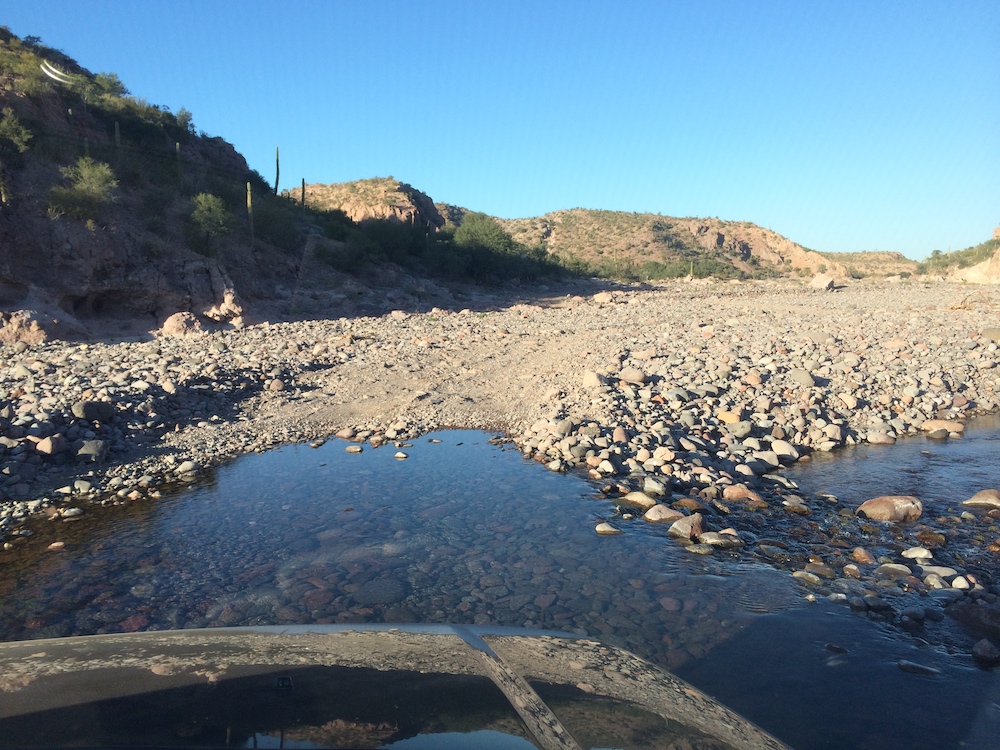


















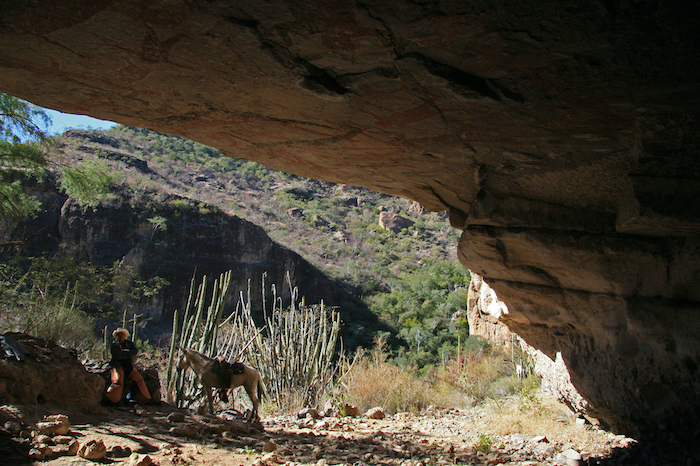
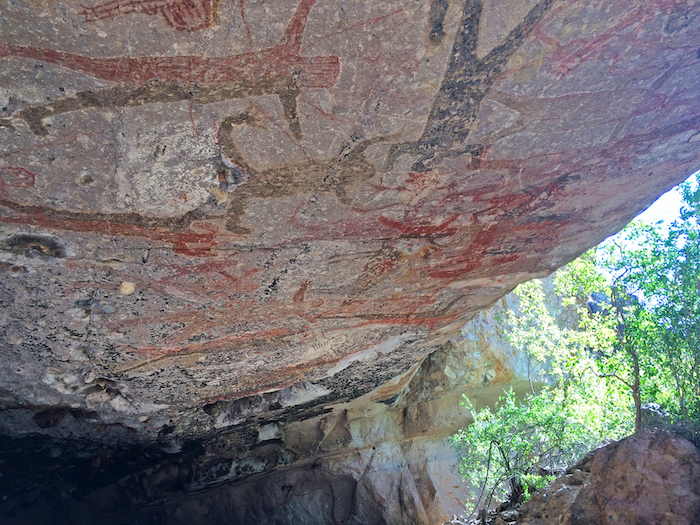

It is a truly amazing place. The canyon is very beautiful also. The road in doesn’t usually require 4wd but high clearance for the rocks and all terrain tires would be nice.
With the past three storms I’m not sure how accessible it is now but the government has been working on the roads out to the ranches.
As of spring 2020, Ciro Cuesta told me he is no longer doing tours of any kind. i spoke with him directly in Mulege.
Earlier this year (2022) I went out to see the San Borjitas cave paintings, and utilized the guide services of Jose Everardo Villavicencio from Palo Verde, BCS (just north of Mulege). He is extremely knowledgeable and did an excellent job; contact info is: everardovillavicencio16@gmail or (615) 159-0707 (c).